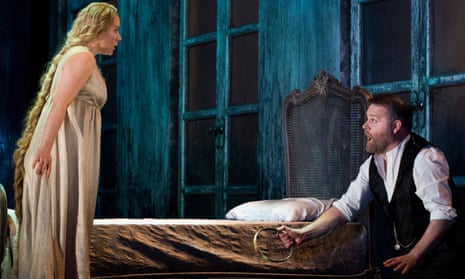Debussy’s Pelléas and Mélisande is the quintessential symbolist opera, sharing its aesthetic with painters such as Odilon Redon and Gustave Moreau. But for David McVicar’s raptly beautiful new production for Scottish Opera it’s another artist contemporary with Debussy who provides the visual starting point, the Danish painter Vilhelm Hammershøi.
The reclusive Hammershøi specialised in subdued colours and quiet, cool interiors, and they are the stuff of Rae Smith’s designs, with costumes that fix the production at the end of the 19th century, when Maeterlinck wrote the play on which Debussy based his libretto. As the opera goes on, the trees of the forest in which Roland Wood’s Golaud first discovers Mélisande (Carolyn Sampson) encroach more and more on the gloomy castle home of the almost blind King Arkel (Alastair Miles).
Mélisande finds herself in a world in which the disconnections are endemic: in the second scene, Golaud’s son Yniold (the excellent Cedric Amamoo) eats a meal alone at table, closely monitored by the servants but ignored by his older relatives. But the way in which she reacts never seems wilful or coquettish; the atmosphere of fateful inertia just gets to her, you sense, and Andrei Bondarenko’s Pelléas offers a possible escape from it. This, after all, is a woman who, in his libretto for Dukas’s Ariane et Barbe-Bleue, Maeterlinck suggested had been one of Bluebeard’s wives. Maybe her desperation also explains the puzzling act of deception she commits in this production, when the hair in which Pelléas entwines himself at the beginning of the third act is clearly not hers, but a blond wig.
The repressed, depressive world is reinforced by Wood’s saturnine Golaud, but nevertheless he makes his character much more sympathetic than he’s often portrayed. He becomes as much a victim of that desperately inward-looking family group as his wife, and McVicar’s perfectly graduated death scene suggests there’s no redemption here, just more of the same to come for Mélisande’s new-born daughter.
The text matters enormously in this opera – as much for what the characters don’t say as for what they do. Sampson’s delicately coloured tone gets every word across in a wonderfully nuanced way; Wood conveys everything, too, more bluntly. But unfortunately very few of Bondarenko’s words come across; he looks and sounds just right as a baritone Pelléas, but at times it’s hard even to work out whether it is French he’s singing.

That’s the only serious shortcoming here. Stuart Stratford paces the score perfectly and the Scottish Opera orchestra play it with every bit of the refinement it needs. Orchestral interludes get full attention, too, for McVicar makes a point of darkening the stage after every scene. The effect is of a picture frame gradually closing, so that the opera becomes a sequence of snapshots of a remorseless private tragedy. It’s altogether a really classy production.

Comments (…)
Sign in or create your Guardian account to join the discussion